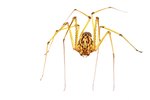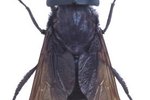
The Amazon rainforest is the largest in the world, and 60 percent of it is in Brazil. Ten percent of the world’s known species lives in the Amazon, including several varieties of bats. Bats play a valuable role in insect population control. However, not all bats are only insectivores. Some live on fruit, fish -- and blood.
Vampire Bats
Vampire bats are the only mammals that have evolved to live solely on blood. They feed mainly on cattle and horses, but will feed on birds and humans. Once they find their prey, they approach it from the ground. The bat has a heat sensor in its nose that detects warm blood flow near the skin, and an anticoagulant in its saliva to keep the blood from clotting as it drinks. They drink approximately a teaspoon -- not enough to deplete a victim. However, they are a carrier of rabies, and in 2005 a mass attack on humans killed 23 people in Brazil.
Greater Bulldog Bats
With an average wingspan of 2 feet, greater bulldog bats are one of the largest bat species in the world. Their chin has skin folds that give them a bulldog appearance. They’re one of the few bats that feed on fish. They use their long legs and curved claws to skim the water as they fly, and echolocation to detect ripples made by fish just below the surface. The can eat up to 40 fish a night and will also feed on shrimp, scorpions and crabs.
Vesper Bats
There are more than 300 species of vesper bats, making them the largest bat family. Because of their numbers they come in assorted colors and weights. They’re not only found in Brazil and other tropical climates, but in temperate climates as well. When living in colder weather, females can delay giving birth. After mating in the fall, they can either store sperm in the uterus until they ovulate in the spring or delay the embryo from implanting. Others carry an implanted embryo, yet it doesn’t develop until the weather is right.
Mustache Bats
The highly developed echolocation ability of mustache bats has been the focus of many scientific studies. Not only do they detect their prey by radar like most bats, but their hearing is so fine-tuned they can tell the species of an insect simply by the echo of the wing beat. Once they hone in on the sound, they have the ability to drown out background interference. The echo tells them the size of the prey, the distance and whether it’s a meal they wish to pursue.
Brazilian Free-Tailed and Disc-Winged Bats
The Brazilian free-tailed bat is named for its noticeably longer tail, which -- combined with their pointed wing design -- makes them excellent long-distance flyers. They’ve been recorded flying more than 30 miles to forage, and flying at heights up to 10,000 feet. Disc-winged bats are named for the suction cups located on their ankles and wrists. These cups allow them to stick to the insides of unfurled banana leaves where they are protected from rain and hidden from predators.
References
- Arkive: Greater Bulldog Bat
- Animal Diversity: Evening Bats and Vesper Bats
- University of Oregon: Neural Mechanisms of Echolocation in Bats
- Animal Diversity: Disc-Winged Bats
- National Geographic: Common Vampire Bat
- BBC News: Rabid Vampire Bats Kill in Brazil
- Animal Diversity: Brazilian Free-Tailed Bat
Photo Credits
-
Anup Shah/Digital Vision/Getty Images
Writer Bio
Slone Wayking worked as a professional in the veterinary field for 20 years. Though her interest in animal health led to this path, Wayking initially studied creative arts. She has been article writing for more than a year and is currently working towards her degree in multimedia. Her certifications include business writing and basic web design.



